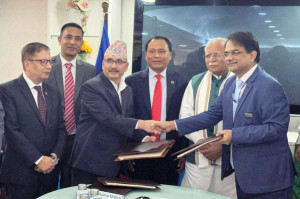Money
Monetary policy expected to help meet growth target
Nepal Rastra Bank (NRB) has revised the cash reserve ratio (CRR) for commercial banks from 6 percent to 4 percent and slashed the interest rate spread from 5 percent to 4.5 percent. Unveiling the Monetary Policy for 2018-19, the central bank announced the new provisions to address a shortage of loanable funds besides reining in soaring interest rates on loans.
Nepal Rastra Bank (NRB) has revised the cash reserve ratio (CRR) for commercial banks from 6 percent to 4 percent and slashed the interest rate spread from 5 percent to 4.5 percent. Unveiling the Monetary Policy for 2018-19, the central bank announced the new provisions to address a shortage of loanable funds besides reining in soaring interest rates on loans.
According to the central bank, the monetary policy is expected to help achieve the government’s economic growth target of 8 percent in the next fiscal year. The central bank said that it had also considered the government’s target to keep the inflation rate at 6.5 percent while devising the monetary policy.
Spread refers to the difference between interest rates on loans and deposits. A reduction in net spread in interest could reduce the pressure on bank and financial institutions to raise the interest rate on loans.
Similarly, cash reserve is the minimum deposit that the banks have to maintain as liquid assets. A reduction in cash reserve also helps banks to increase the money supply in the market.
NRB has reduced the interest spread after five years. However, for microfinance companies, the spread has been fixed at 6 percent. The central bank said it would be reducing the spread rate successively to the prescribed limit by mid-July 2019.
Earlier, the cash reserve limits for A, B and C class financial institutions were 6 percent, 5 percent and 4 percent respectively. Under the new provision, all these institutions have to maintain a 4 percent cash reserve. It will add Rs48 billion worth of liquidity in the market which will reduce pressure on the base rate.
The central bank has also revised the upper limit in the interest rate corridor to 6.5 percent from the existing 7 percent. Similarly, the lower limit of the interest rate corridor on two weeks lending has been increased to 3.5 percent from 3 percent. The reduction in the gap of the interest rate corridor is expected to stabilise the fluctuation in the interest rate seen at present.
With the new policy in effect, commercial banks can enjoy their freedom to take loans of up to 25 percent of their primary capital in Indian currency too. Earlier, the provision was applicable only to foreign currencies other than Indian currency. The central bank has now maintained a similar provision for microfinance institutions.
Apart from injecting additional liquidity and stabilising the interest rate, the policy has also aimed to maintain financial discipline in the domestic market and expand people’s access to financial services. As per the new provision, commercial banks do not have to take permission from NRB to open branches in locations outside metropolitan and sub-metropolitan cities. The central bank has raised the deposit guarantee limit to Rs300,000 from the existing Rs200,000.
The monetary policy has also revised the limit of overdraft on individual loans. In the new provision, banks can provide only up to Rs5 million in overdrafts to an individual. The limit was Rs7.5 million earlier. The revised overdraft limit is expected to increase loans in the productive sector, according to NRB.
By maintaining the minimum threshold of loans in the priority sector at 25 percent, NRB has asked commercial banks to provide at least 10 percent of the loans to the agricultural sector and 15 percent to energy and tourism. The limits for development banks and finance companies in the priority sector have been kept unchanged at 15 percent and 10 percent respectively. The private sector has welcomed NRB’s new monetary policy with caution. Although the expansionary monetary policy is expected to address the government’s target of economic growth, it might fail to maintain the inflation rate within targeted limits, said the private sector.
Shekhar Golchha, senior vice-president of the Federation of Nepalese Chambers of Commerce and Industry, welcomed the move to reduce the cash reserve limit and spread rate and allow banks to take loans in Indian currency too. “However, the policy is silent on increasing the time limit on refinancing for the industrial sector,” Golchha said.




 23.12°C Kathmandu
23.12°C Kathmandu














